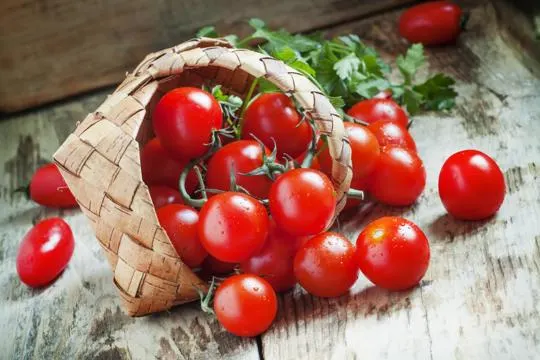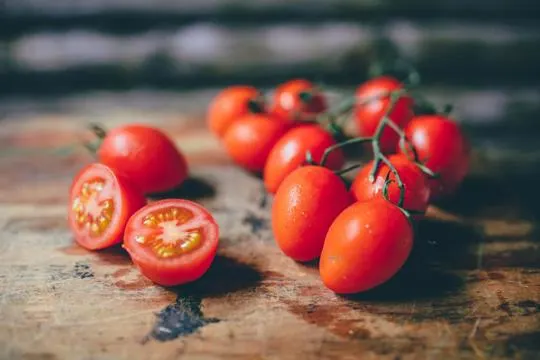Believe it or not, those little cherry tomatoes and their bigger cousins have some secrets. First off, size matters here. Cherry tomatoes are like the snack-size version of the regular ones. Perfect for popping in your mouth. No need for a knife.
Regular tomatoes? Well, they’re the big leagues. Cut ’em, cook ’em, do whatever.
We’ve all been there, choosing between the two. I mean, who hasn’t stood in the produce aisle, perplexed?
Our personal showdown? Making salad. Cherry tomatoes are a breeze. Regular tomatoes need some prep.
Both bring something to the table. Flavor, texture, uses. We’ve got opinions. And so do they.
In this piece, we’re breaking it down. No fluff, just facts. And maybe a laugh or two, because, really, it’s tomatoes we’re talking about.
What are Cherry Tomatoes?

If you’re wondering what exactly cherry tomatoes are, then you’ve come to the right place.
Cherry tomatoes, also known as cocktail tomatoes, are just smaller versions of regular tomatoes, usually about the size of a cherry, hence the name.
These miniature tomatoes are known for their sweet flavor and bright red color.
They come in a variety of shapes, such as round, oval or pear-shaped, and can be found in many different colors, including red, yellow, and even black.
Whether eaten raw, roasted, or in a salad, cherry tomatoes are a delicious addition to any dish.
So next time you see these little red gems at the grocery store, grab a handful and give them a try.
What are Regular Tomatoes?

Regular tomatoes, also known as slicing tomatoes, are a common delight.
They belong to the Solanaceae family and have a smooth skin and fleshy texture.
They come in multiple colors like red, orange, yellow, and green when unripe.
These fruits can be eaten raw in salads or sandwiches.
Or you can cook them in sauces, stews, or roast them for more flavor.
Regular tomatoes bring a balance of sweet and sour taste.
Their flesh is firmer than cherry tomatoes, making them perfect for slices and dicing.
Regular tomatoes come in various sizes and shapes.
Beefsteak, plum, or Roma – each type has its own characteristics.
This variety makes creative presentations and adds visual appeal to dishes.
These tomatoes are packed with essential nutrients like vitamin C, potassium, fiber, and antioxidants.
These nutrients boost immunity, maintain healthy blood pressure, help digestion, and fight oxidative stress.
Whether you want to add more flavor or nutrition, regular tomatoes are just the thing.
Their versatility makes them a staple ingredient in many cuisines.
Unlock the potential of these delightful fruits in your next gastronomic adventure.
Size and Shape Differences between Cherry Tomatoes and Regular Tomatoes

Cherry tomatoes and regular tomatoes? Quite distinct.
Cherry tomatoes are small, like a cherry or grape.
They have a smooth skin and are usually bite-sized.
Regular tomatoes, though, vary in size and shape – from small to large, round, oblong, or irregular.
Unlike cherry tomatoes, regular tomatoes offer more variety.
Flavor and Taste Comparison of Cherry Tomatoes and Regular Tomatoes
Comparing cherry tomatoes and regular tomatoes? There’s a few differences to keep in mind.
Cherry tomatoes are sweet and juicy, with a tartness that adds delight.
Regular tomatoes offer a more balanced flavor with a hint of acidity – savory and delicious.
Texture-wise, cherry tomatoes have a firm skin with a tender interior.
They’re small, so great for snacking or adding to salads.
Regular tomatoes have a larger size and firmer flesh – perfect for slicing or dicing.
Cherry tomatoes are great raw, while regular tomatoes can be cooked up too.
Try roasting or simmering them for a sweet, caramelized flavor.
Nutritional Differences between Cherry Tomatoes and Regular Tomatoes
Cherry tomatoes – little and sweet – are nutrient powerhouses.
These tiny treats are enriched with vitamins A and C, potassium, and fiber.
Regular tomatoes, though, have more water and an antioxidant, lycopene.
It is associated with health advantages.
Both tomatoes have different nutritive values, but cherry tomatoes are especially tasty and nutrient-dense.
Uses and Culinary Applications of Cherry Tomatoes and Regular Tomatoes
Cherry tomatoes and regular tomatoes have their own special uses.
Cherry tomatoes are small and full of flavor, great for salads, salsas, or as a garnish.
Regular tomatoes, because they’re bigger, are good in sandwiches, sauces, soups, and roasted dishes.
They give dishes extra flavor.
And cherry tomatoes can be eaten raw or paired with cheese.
Both can be cooked down into a sauce or puree to add taste to recipes.
Cherry tomatoes look nice in kebabs and on skewers when grilling.
Their small size makes them fit well in pasta dishes and stir-fries.
Whether you choose cherry tomatoes or regular ones, both bring unique flavors that can excite your taste buds.
Key Factors to Consider When Choosing between Cherry Tomatoes and Regular Tomatoes

When it comes to choosing between cherry and regular tomatoes, there are several factors to think about.
It’s best to make a decision based on your preferences and needs.
Size is an important factor.
Cherry tomatoes are much smaller than regular ones.
This can be great if you like bite-sized fruits or if you plan to use them for garnishing salads.
Regular tomatoes are larger and more suited for slicing and cooking.
Taste is another factor.
Cherry tomatoes have a sweeter and more intense flavor.
They can add a sweet burst to any dish.
Regular tomatoes have a milder flavor that works in a variety of recipes.
Texture also differs.
Cherry tomatoes have thicker skin and less juice.
They’re easier to handle and are less messy.
Regular tomatoes have juicier flesh and thinner skin – perfect for dishes like sandwiches or salsas.
Nutrition is another factor.
Both types offer health benefits, but cherry tomatoes tend to be higher in vitamin C and antioxidants.
Regular tomatoes have more lycopene, which may benefit heart health.
Lastly, availability and price can influence your choice.
Cherry tomatoes are available year-round but they can be more expensive.
Regular tomatoes are widely available and prices vary depending on the season.
Storage and Shelf Life Differences
Cherry tomatoes and regular tomatoes have differences when it comes to storage and shelf life.
Cherry tomatoes typically stay fresh longer.
One reason is their smaller size, resulting in less moisture content.
The thick skin helps too, as a barrier against external factors like air and humidity.
Unripe cherry tomatoes can be stored at room temperature, but regular tomatoes should be kept in the fridge once ripe.
So, overall, cherry tomatoes have a longer shelf life due to their size and skin.
Conclusion
It is easy to see that cherry tomatoes and regular tomatoes offer different flavor profiles, color aesthetics, and nutritional value.
Cherry tomatoes provide a sweet taste with more natural sugars than regular tomatoes.
Additionally, they have dense and firm flesh which makes them great for a range of recipes.
Regular tomatoes, on the other hand, come in many shapes and sizes.
Their juicy flesh provides a savory taste that can help enhance any dish with its deep flavors.
No matter which one you choose between cherry versus regular tomatoes depends on your own individual preferences while nutrition wise there isn’t really much of a difference.
You can’t really go wrong with either choice; the important thing is to bless your kitchen counters and leave room for both.
Try out some recipes using each type of tomato and see which works best for your tastes buds.
With all these factors in mind, you can now make an informed decision between choosing cherry tomatoes or regular ones the next time you go grocery shopping.

Leave a comment